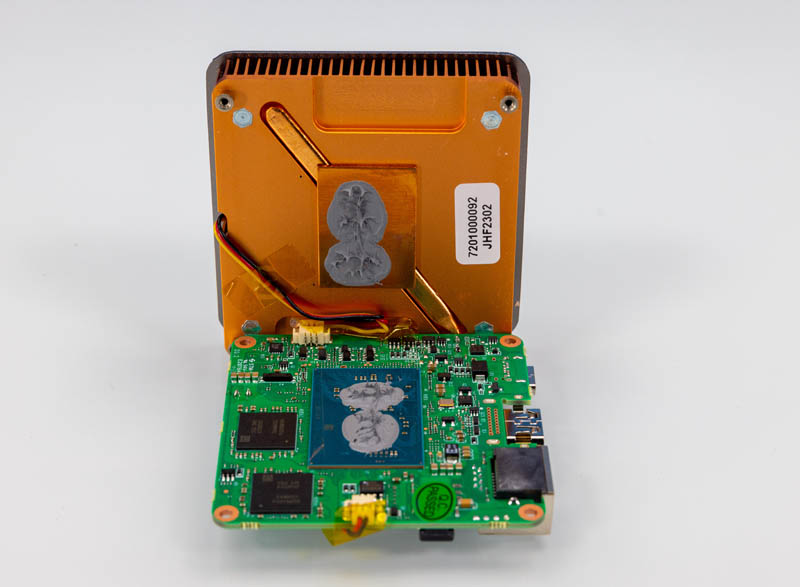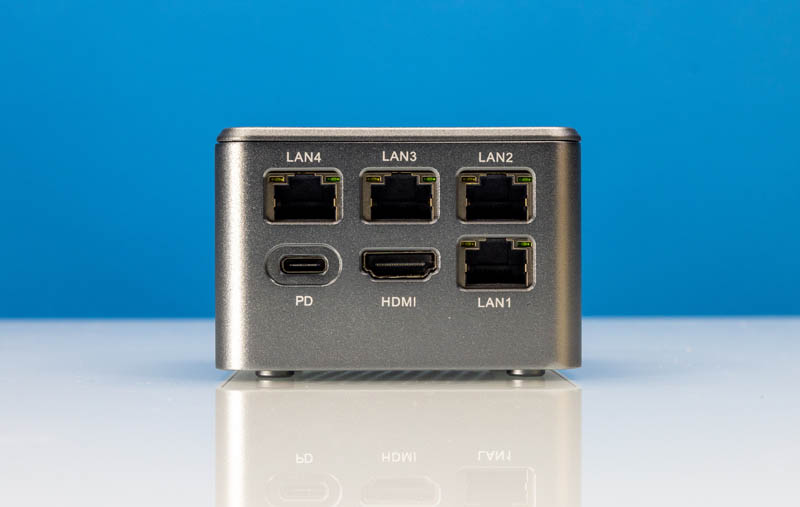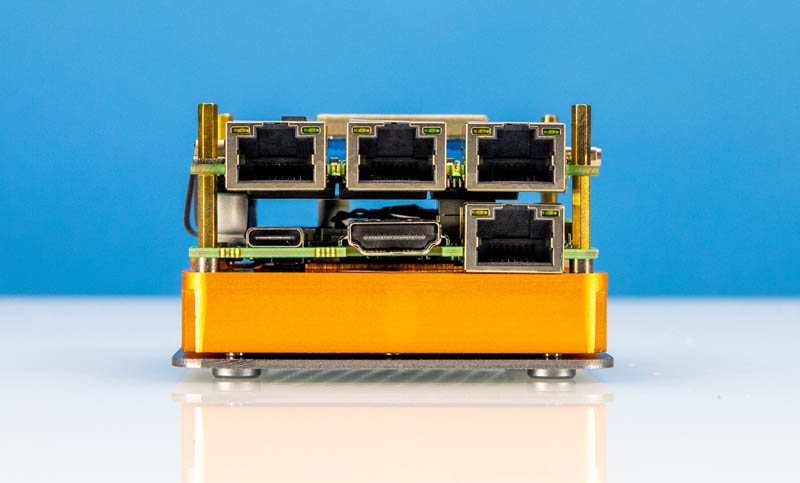Next, let us get to the power consumption and noise.
iKoolCore R1 Power Consumption and Noise
Power consumption is fairly low. The unit has a USB-C PD input. With the R1, we get an iKoolCore 30W power adapter with a USB-C end. The unit also comes with a DC barrel jack to USB-C adapter that we did not use.

We got around 12.4-12.5W in Proxmox VE 7.3 with one 2.5GbE NIC linked. Peak power was in the 22-24W range, but there may be 3-4 watts more there for longer 2.5GbE cables. Using this under load it got warm, but it did not fail.

If you want to hear the unit, check out our video. The 34dba sound floor studio was under 40dba from a desktop-to-ear distance. Perhaps watching the video is more instructive since you can hear the type of fan noise this generates.
Next, let us get to our key lessons learned.
Key Lessons Learned
First off, this machine was very cool. At the same time, having the top-end unit there were some lessons learned. The first is just around the CPU. For a personal machine, I might be inclined to get a N5105 instead of a N6005 CPU to save a few dollars.

The big one, however, is really just trying to answer the question “what in the heck is this for?” That is a great question. On one hand, it is a great and compact router platform with 4x 2.5GbE NICs. On the other hand, a fanless unit makes a lot of sense in embedded applications. For those that want 10GbE, the R86S with 2.5GbE and 10GbE networking probably makes more sense.

Then, at some point, it hit me. This is extremely portable. It fits in a pocket. One can power it via a portable battery bank. Perhaps the best use for this machine is as a portable box. Putting something like Ubuntu desktop on this gives a ton of flexibility as a portable service node.
There is still one thing this system is missing: WiFi. One could add USB-based WiFi, but that feels like one feature that would be super useful for a portable machine, especially powered by a portable battery.
Final Words
There are systems that we review that are cool (or iKoolCore?) because of the features that they offer. Some of those systems also make you take a step back and ask, “why?” This is certainly one of those systems.

The lack of internal WiFi is perhaps the one change that would expand the use cases for this system significantly. At the same time, it is hard to convey just how small this is. We could say 75mm x 75mm x 48mm or 2.95″ x 2.95″ x 1.98″ and you can get some idea. In the video, this system was brought on set in a coffee mug and later placed into a pocket.

The prospect of having a portable setup with multiple 2.5GbE NICs is really interesting. This is one where a 3-5 node cluster could be placed in a carry-on or even a slick briefcase. My sense is that for folks that want small router/ firewall units, this will be interesting. Where it will excel is for those that need nodes or clusters to go.




There are obvious reasons to prefer the dedicated hardware(that little fan definitely isn’t ‘shove into corner, forget about for a decade’ material); but it feels downright weird to see 4x 2.5GbE NICs and an entire computer, albeit a deeply undistinguished one, sitting only $50 higher than the MS105 5-port unmanaged switch.
Totally agree. Hoping Thursday this week we launch the “cheap” 2.5GbE switch round-up/ buyer’s guide.
This thing looks like it ought to fit in very nicely with all the other Raspberry Pi-sized boxes out there. And who wouldn’t want a “cute little pet computer” adorning their desktop? :-)
Professional IT male experts with giant rack cabinets in their living room should not feel threatened by this. It is okay to admit that you like cute hardware.
Nice unit, but the core problem is that alot of libraries now are compiled with SEEE2 and AVX2 by default, and this cpu plattform doesnt support it.. I met this the hard way the other day. Even RabbitMQ AMQP messagebus container by default is using avx2..
I’d like to see all these mini things with vPro iKVM – I know that we can get other solutions, but it would be nicer and easier with iKVM.
Here’s a use-case: routers for RV travelers. With Starlink being viable mobile (albeit stationary) broadband, a power-sipping pico-sized fanless router absolutely makes sense. You could also bind the WiFi link to the WAN side of things and connect to any available public WiFi network (though double-NAT may become an issue).
Is the “IKoolCore R1 Topology” on page 3 human made in Visio / photoshop or is a software that pulls all of those details from the host and does that nice image?
Very interesting find! May give it a try as a low-power draw OPNsense router.
Like mevtec, I’m also wondering how the image “IKoolCore R1 Topology” on page 3 was generated.
@mevtec I’m pretty sure that it’s lstopo output. Provided by hwloc; though normally to be found in, or not too far outside, standard repositories of common Linux distributions.
https://www.open-mpi.org/projects/hwloc/
Amazing unit. Thank you for your review
Thanks for you review. I bought the unit and while testing I found out there are no I226 drivers for Windows server? Win11 drivers don’t work. Did anyone see the driver around? I checked, there are couple bundles on intel website, but i226 isn’t included in any of them :(
Thanks for you help.
It is something I was looking for!